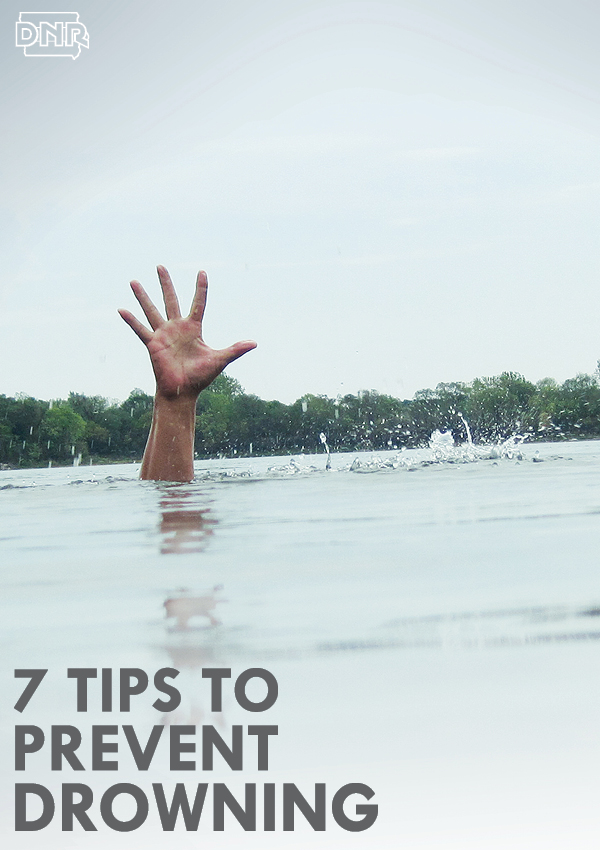 Each year, drownings affect a wide swath of outdoor users, from people swimming in lakes and rivers, standing on docks and wading in rivers to warm-weather anglers, ice anglers and boaters. As hotter summers push more Iowans toward water, drownings can increase. Luckily, many of these deaths are preventable.
Each year, drownings affect a wide swath of outdoor users, from people swimming in lakes and rivers, standing on docks and wading in rivers to warm-weather anglers, ice anglers and boaters. As hotter summers push more Iowans toward water, drownings can increase. Luckily, many of these deaths are preventable.
The main causes of drowning are: lack of swimming ability, alcohol use, failure to wear life jackets, lack of barriers to unsupervised swimming areas, lack of close supervision while swimming, location and seizure disorders. Heed these statistics and top tips to stay water safe. Some are common sense, but others require skills or action to avoid tragedy.
Become Proficient Roughly one-third of Americans lack adequate swimming skills. Swimming is a life-saving, life-long skill worth knowing. Bolster your abilities or learn to swim by taking formal swimming lessons. Inquire at municipal pools, colleges and YMCA facilities.
Wear Life Jackets Based on U.S. Coast Guard statistics, nearly 75 percent of boating deaths result from drowning. In nearly 90 percent of those deaths, life jackets were not worn. Wear properly sized, U.S. Coast Guard-approved life jackets regardless of the distance traveled, boat size or swimming ability. In 2007, 29 percent of boating deaths nationwide occurred on boats that were anchored, docked, moored or drifting.
Avoid Beer and Booze Among adolescents and adults, alcohol is involved in up to 70 percent of water recreation deaths, nearly a quarter of emergency room visits for near-drowning and about one-in-five boating deaths. Alcohol alters balance, coordination and judgment. Its effects are amplified by sun exposure and heat. Stay sober near waterbodies.
Learn CPR CPR from a bystander is proven to save lives and improve outcomes for near-drownings. The quicker CPR begins, the better the results. In the time needed for paramedics to arrive, your CPR skills could save a life or prevent permanent damage. If already certified, learn the latest techniques and refresh your skills by recertifying. Inquire at your local hospital, workplace or doctor’s office for classes.
Have Eagle Eyes Close By A responsible adult needs to constantly watch young children when swimming or playing near water as drowning occurs quickly and quietly. Be close enough to touch the child at all times. A submerged person is often difficult to find due to Iowa’s low-visibility water.
Know the Terrain Iowa rivers and lakes can have sudden dropoffs, holes, submerged shelves, foot holds and rock ledges. Exercise caution near all waters. Current strength is often deceiving even for strong swimmers.
Avoid Obvious Hazards On rivers, stay clear of sweepers and strainers—fallen trees and logs that lay across portions of waterways where currents can hold watercraft and occupants underwater. Avoid dropoffs near sand and gravel bars. On large rivers, sudden dropoffs can measure more than 5 feet, posing hazards for children and weaker swimmers. Re-circulating, powerful currents from even small low-head dams are unforgiving drowning machines. Stay clear above and below all dam areas.
To Help a Drowning Person:
To rescue a drowning person, remember the Reach, Throw, Row and Go steps from The American Red Cross:
First try to reach victim with whatever is available. Stay onshore and extend a branch, pole or rope to pull victim ashore.
Second, try to throw a line, buoy or floating object. Or remove your shirt, kneel down while holding one sleeve and throw out the other sleeve. Remove pants to tie one leg to sleeve to increase reach.
Row, or use a watercraft, when the victim is farther out. In a canoe, kneel and paddle alongside so the victim can grasp the side to tow to shore.
Go as a last resort only if the first three steps can’t be used. Keep eyes on victim and remove shoes and excess clothes. Jump, do not dive, into water. Carry a shirt, pants or towel clenched in your teeth. Swim near enough to extend clothing and tow victim. If you have nothing to extend, approach victim from behind and tow to safety by the hair. Don’t allow victim to latch onto you and never attempt a rescue beyond your swimming ability.
This article originally appeared in the May/June 2013 issue of Iowa Outdoors magazine.